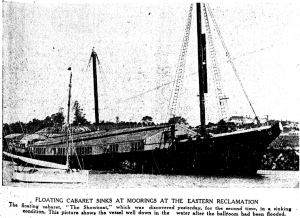Today’s #throwbackthursday features one of the abandoned vessels on Rangitoto Island. Columbia, later known as the Showboat, was a four-masted schooner constructed in 1899 in Washington, USA. In the earlier years of its life, the vessel was employed in the timber trade around the North Pacific. In 1926, the ship sailed to Napier, New Zealand, with a cargo of timber. In September of the same year, the ship was purchased by the Devonport Ferry Company and sailed to Auckland to be converted into a coal hulk.

The American four-masted schooner Columbia, purchased by the Devonport Ferry Company. Auckland Star, Volume LVIII, Issue 230, 28 September 1926, Page 8
During this conversion, the vessel was stripped of useful material including, sails, rigging, and machinery. The vessel was then moored in Freeman’s Bay, Auckland and there it would stay for another 9 years. Freeman’s Bay became know as ‘Rotten Row’ due to the number of moored hulks.

Crane dismantling Columbia 1926. New Zealand Herald, Volume LXIII, Issue 19448, 2 October 1926, Page 13

Stripping the vessel of anything useful. New Zealand Herald, Volume LXIII, Issue 19452, 7 October 1926, Page 13
On 9th December 1935, Columbia was once again sold and this time converted into a floating cabaret. It seemed like a good business idea at the time, however the venture was never successful. The business changed hands twice and the vessel was subjected to a suspected sabotage attack where it sunk while moored at the Eastern Reclamation.

Columbia hulk being converted into the Showboat. New Zealand Herald, Volume LXXII, Issue 22287, 9 December 1935, Page 8

Floating cabaret sinks at the Eastern Reclamation. New Zealand Herald, Volume LXXV, Issue 22976, 2 March 1938, Page 17
In 1938, with the cabaret no longer making a profit, the decision was made to sell the vessel for demolition. When the deadline for tenders closed on the 16th September 1938, it seemed no one wanted to touch it. The decision was then made to tow the vessel to the Rangitoto Island ships’ graveyard. On 27th October 1938, the vessel went up in flames. /KB

Sir George Grey Special Collections, Auckland Libraries, AWNS-19381102-44-2











